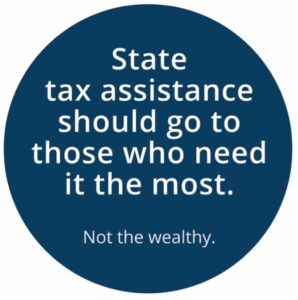This November, Governor Gianforte released his proposed budget, which included a state child tax credit (CTC). For families with children, a state CTC is one of the best-targeted ways to reduce poverty if they are structured to reach those with the lowest wages. The executive budget includes a CTC set at $1,200 per child under the age of six.
With this proposal on the horizon for the next legislative session, let’s look at CTCs, why they are important, and how to best structure them. While we don’t yet have the details on the governor’s proposal, we will cover the research on the most effective ways to structure CTCs to maximize their benefits for families.
What is a child tax credit?
States have options to reduce poverty via state-level tax credits, such as earned income tax credits (EITCs), property tax credits, and CTCs. Twelve states, including Idaho, have enacted state CTCs, and ten others have introduced legislation to create or expand a state-level credit since 2019. While 119,000 households in the state currently benefit from the federal CTC, Montana currently has no state CTC.
Why is a state CTC important for Montana?
The CTC has gained plenty of attention over the past few years, primarily because of the expansion of the federal CTC. In 2021, Congress increased the federal CTC by $1,000 for children over the age of six and by $1,600 for those under the age of six. For the first time ever, the federal CTC was also made fully available to those living in poverty (more on that below).
As the credit was made fully available to those living in poverty, it led to widespread reductions in childhood poverty. If the credit had been made permanent, it would have helped lift 45 percent of all Montana children and 59 percent of American Indian/Alaska Native (AI/AN) children in Montana out of poverty.
Unlike a tax cut for the wealthy, a state CTC would help people struggling with the rising prices of goods, the high cost of child care, and high housing costs.
What’s the best way to structure a child tax credit?

Child tax credits help families with the cost of raising children, but to help lift families out of poverty; they need to be structured in a certain way. The best way to structure a tax credit involves something called “refundability,” which means a credit is fully available to families living on low incomes.
If a tax credit is refundable, families receive the full amount of the credit even if their tax bill is less than the size of the credit. The remaining amount goes to the family as a refund. Families can then put their tax refund towards expenses, which helps reduce economic hardship while supporting local economies.
Refundability is one of the best ways to ensure that tax credits reduce poverty and inequity. If a credit is not refundable, a state spends far more resources on people living on high incomes. Non-refundable tax credits further unbalance our tax code and reinforce racial and economic disparities.
CTCs should also have an upper-income limit so that state resources are being invested in people who could most use tax assistance, not the wealthy. Wealthy taxpayers are also disproportionately white, meaning tax cuts for the wealthy end up reinforcing racial wealth gaps. A targeted and refundable state CTC can help ensure all Montana families can provide for their children – no matter their race.
We should note that the executive branch’s proposed CTC is only for families with children under the age of six. Families with younger children are more likely to live in poverty than those with older children. In Montana, 17 percent of children under age six live in poverty, compared to 13 percent of those aged six to 17. A tax credit targeted to young children can help reduce poverty during critical developmental years, but it nevertheless leaves behind thousands of children still living in poverty.
What are the benefits of a CTC?
The evidence from the temporary boost in the federal CTC in 2021 highlights how Montanans used their CTC and the clear benefits of the credit. Over half of Montana parents bought food for their family, resulting in fewer food-insecure families. Parents also used the credit to pay down debt, manage bills, afford child care, and buy clothing and school supplies.
Despite the immediate benefits, the effects of larger CTCs aren’t temporary. Increases in CTCs have also been linked to better school performance and higher future earnings. A child allowance is also associated with less involvement from child protective services and criminal justice services.
What other tax credits can benefit workers and families?
A CTC has the potential to improve the lives of thousands of Montana families if structured in a way that benefits those who need it the most. The state can also pursue other tax credits that would help improve inequities in our tax code. These changes would include an increase to the Earned Income Tax Credit (which was not included in the governor’s budget) and an expanded property tax credit.
For more information on the CTC and these other tax credits, read our latest report, Tax Credits for Workers and Families.

MBPC is a nonprofit organization focused on providing credible and timely research and analysis on budget, tax, and economic issues that impact low- and moderate-income Montana families.